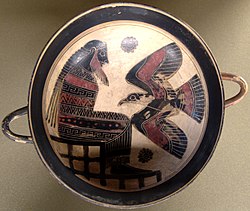Spartan Army
| Sparta |
 Zeus on his throne with his eagle This article is part of the series: |
|
Great Rhetra Laws of Lycurgus Politeia |
|---|
|
List of Kings of Sparta Gerousia Ephorate Apella of the Damos Spartiates Perioeci Helots Agoge Syssitia |
|
Spartan army • Other Greek city-states • |
This article is part of the series:
Spartan Constitution
The Spartan army stood at the center of the Spartan state, whose citizens were trained in the discipline and honor of the warrior society. Subject to military drill from early manhood, the Spartans were one of the most feared military forces in the Greek world. At the height of Sparta's power – between the 6th and 4th centuries BC – it was commonly accepted that "one Spartan was worth several men of any other state." According to Thucydides, the famous moment of Spartan surrender on the island of Sphacteria, off Pylos, was highly unexpected. He said that "it was the common perception at the time that Spartans would never lay down their weapons for any reason, be it hunger, or danger."
The iconic army was first developed by the semi-mythical Spartan legislator Lycurgus. Referring to Sparta having a "wall of men, instead of bricks", he proposed to reform Spartan society to create a military-focused lifestyle in accordance with "proper virtues" such as equality for the male citizens, austerity, strength, and fitness. A Spartan man's involvement with the army began in infancy when he was inspected by the Gerousia. If the baby was found to be weak or deformed he was left at Mount Taygetus to die, since the world of the Spartans was no place for those who could not fend for themselves. It should be noted, however, that the practice of discarding children at birth took place in Athens as well. Those deemed strong were then put in the agoge regime at the age of seven. Under the agoge the young boys or Spartiates were kept under intense and rigorous military training. Their education focused primarily on cunning, sports and war tactics, but also included poetry, music, academics, and sometimes politics. Those who passed the agoge by the age of 30 were given full Spartan citizenship.
The term "" became synonymous with fearlessness, harsh and cruel life, endurance or simplicity by design.
The first reference to the Spartans at war is in the Iliad, in which they featured among the other Greek contingents. Like the rest of the Mycenaean-era armies, it was depicted as composed largely of infantry, equipped with short swords, spears, and Dipylon-type ("8"-shaped simple round bronze shields). This was the Golden Age of Warfare.
...
Wikipedia
